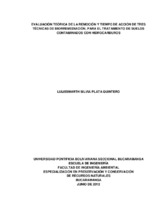| dc.contributor.advisor | Gamarra Hernández, Yolanda | |
| dc.contributor.author | Plata Quintero, Luijesmarth Silvia | |
| dc.coverage.spatial | Seccional Bucaramanga. Universidad Pontificia Bolivariana. Escuela de Ingenierías. Facultad de Especialización en Preservación y Conservación de Recursos Naturales | spa |
| dc.coverage.temporal | 2012 | |
| dc.date.accessioned | 2014-09-10T15:41:28Z | |
| dc.date.available | 2014-09-10T15:41:28Z | |
| dc.date.created | 2013-05-11 | |
| dc.date.issued | 2014-09-10 | |
| dc.identifier.uri | http://hdl.handle.net/20.500.11912/1812 | |
| dc.description | 38p.: (pdf); tablas | spa |
| dc.description.abstract | El objetivo de este proyecto fué evaluar teóricamente la remoción y tiempo de acción de tres técnicas de biorremediación, para el tratamiento de suelos contaminados con hidrocarburos. Se estableció una metodología en la cual se identificaron todas las técnicas de biorremediación implementadas actualmente. Posteriormente se revisó el estado del arte de cada una de ellas y se seleccionaron las tres técnicas que se compararon: bioventing, bioaumentación y bioestimulación, como consecuencia del análisis y discusión presentan los mejores resultados. Se compararon los diferentes estudios realizados en las tres técnicas seleccionadas y la bioestimulación es la mejor alternativa de biorremediación, debido a sus altas eficiencias de remoción en un periodo de tiempo corto. Los resultados obtenidos indican que la mejor opción de tratamiento es la combinación de las tres técnicas seleccionadas para lograr altas tasas de biodegradación de los hidrocarburos en menor tiempo. | spa |
| dc.description.abstract | The objective of this project was to evaluate theoretically the removal and time of action of three bioremediation techniques for the treatment of soil contaminated with hydrocarbons. Established a methodology in which we identified all currently implemented bioremediation techniques. Subsequently reviewed the state of the art of each of them and selected three techniques to be compared: bioventing, bioaugmentation and biostimulation as a result of the analysis and discussion presented the best results. The different studies in the three selected techniques were compared and biostimulation is the best alternative for bioremediation because its high removal efficiencies in a short time. The results obtained indicate that the best treatment option is the combination of the three selected techniques to achieve high rates of biodegradation of hydrocarbons in less time. | |
| dc.language.iso | es | |
| dc.publisher | Universidad Pontificia Bolivariana | spa |
| dc.rights | Attribution-NonCommercial-NoDerivatives 4.0 International | * |
| dc.rights.uri | http://creativecommons.org/licenses/by-nc-nd/4.0/ | * |
| dc.subject | Especialización en preservación y conservación de los recursos naturales | spa |
| dc.subject | Tesis y disertaciones académicas | spa |
| dc.subject | Hidrocarburos | spa |
| dc.subject | Contaminación de suelos | spa |
| dc.subject | Bioderremediación | spa |
| dc.subject | Biodegradación | spa |
| dc.title | Evaluación teórica de la remoción y tiempo de acción de tres técnicas de biorremediación, para tratamiento de suelos contaminados con hidrocarburos | spa |
| dc.type | book | spa |
| dc.rights.accessRights | openAccess | spa |
| dc.type.hasVersion | publishedVersion | spa |
| dc.identifier.instname | instname:Universidad Pontificia Bolivariana | spa |
| dc.identifier.reponame | reponame:Repositorio Institucional de la Universidad Pontificia Bolivariana | spa |
| dc.identifier.repourl | repourl:https://repository.unab.edu.co/ | |


